Archie Baird Interview
Archie Baird’s zest for golf and almost everything connected with it would charge the stoniest sport-hater with a sense of the potential charisma of the game.
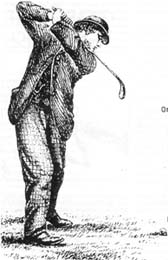 He has amassed a marvellous collection old clubs, balls, golf books, pictures, ceramics and silver. His study walls are decked with rows of wooden golf clubs, the earliest dating from the eighteenth century, beautiful objects in their combination of delicacy and strength; above the desk hangs a reproduction of The Acts of King James the Second, 1566, the first printed reference to golf, in which James decreed that, ‘the football and the golf should be utterly cried doon and not usit’; in the bookcases flanking the door resides a well-loved and well-read collection of golf books, and the fact that some of them have become rather valuable in monetary terms has failed to convert them to the status of untouchable investments for this collector. He had the fortune to start making his collection well before the current vogue for golf memorabilia sent prices spiralling. He took up golf on becoming a vet in Edinburgh in 1954.
He has amassed a marvellous collection old clubs, balls, golf books, pictures, ceramics and silver. His study walls are decked with rows of wooden golf clubs, the earliest dating from the eighteenth century, beautiful objects in their combination of delicacy and strength; above the desk hangs a reproduction of The Acts of King James the Second, 1566, the first printed reference to golf, in which James decreed that, ‘the football and the golf should be utterly cried doon and not usit’; in the bookcases flanking the door resides a well-loved and well-read collection of golf books, and the fact that some of them have become rather valuable in monetary terms has failed to convert them to the status of untouchable investments for this collector. He had the fortune to start making his collection well before the current vogue for golf memorabilia sent prices spiralling. He took up golf on becoming a vet in Edinburgh in 1954.
I had to give up playing rugby, because I couldn’t possibly afford to pay a locum to do my practice if I was injured. An alternative sport was golf. I joined the Gullane Golf Club, and enjoyed my golf tremendously. Even if I only had a couple of hours free, I could come down to Gullane and beat a golf ball round the hill and go back to Edinburgh feeling physically and mentally refreshed.
When we were first married in the early 1950s, Sheila and I started looking for furniture, and as we were very modestly placed financially, we used to go to the lane sales down at Silvermills and the back of George Street. The lane at Silvermills was our best venue, we used to find all our best things there. The sales were held in the open air in a great big yard. One day we were looking for furniture and I saw a canvas bag which contained old fashioned golf clubs. I rubbed the dust off them, and the name that appeared was W. Park, Musselburgh. Now, Willie Park, Senior was Sheila’s great-grandfather. He was also the first winner of the Open Championship at Prestwick in 1860. And I thought- Just for a lark, I must have these clubs, it would be super to have them. Beautiful craftsman-made objects. They’re signed, over a hundred years old, nobody wants them. I bid for them, and got the whole bag for only 5/-. I realised it would be a fascinating hobby to collect old golf clubs, and a rewarding one, because every junk shop in Edinburgh had them and nobody wanted them. So I began to go round, looking first of all for Willie Park clubs.
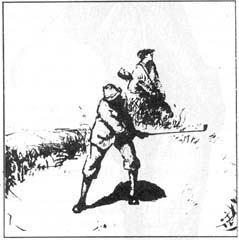 Then I started to notice clubs made by other people, Philp, for instance. His clubs looked to me to be of particular merit. I began to buy old golf books to find out about club-makers. Old golf books were easy to find. I wasn’t interested in anything published after 1900. I found a basic bibliography of golf and began to tick off the things that I had. I wanted to collect things with information about the development of the game. It wasn’t difficult to get practically everything that had been printed before 1900, except for the really rare items, which I wasn’t terribly interested in, because they weren’t going to tell me about club-makers. Before long I had almost everything that I could reasonably expect to find. I don’t pursue mint copies. A good reading copy will satisfy me, although I might replace it if I find one in better condition. I don’t share the perfectionist aspirations of some collectors.
Then I started to notice clubs made by other people, Philp, for instance. His clubs looked to me to be of particular merit. I began to buy old golf books to find out about club-makers. Old golf books were easy to find. I wasn’t interested in anything published after 1900. I found a basic bibliography of golf and began to tick off the things that I had. I wanted to collect things with information about the development of the game. It wasn’t difficult to get practically everything that had been printed before 1900, except for the really rare items, which I wasn’t terribly interested in, because they weren’t going to tell me about club-makers. Before long I had almost everything that I could reasonably expect to find. I don’t pursue mint copies. A good reading copy will satisfy me, although I might replace it if I find one in better condition. I don’t share the perfectionist aspirations of some collectors.
During the war I was a pilot, and I had a great pal who was a rear-gunner who went to the Art College in Edinburgh on a scholarship after the war ended. He persuaded me to go to Paris with him one summer. I made the journey on an old 1928 motor bike which was bought for £4 10/-. We set off with as much coffee and tea as we could afford to buy and managed to stay in Paris for a month on £10. We went round all the art exhibitions. I got a big kick out of looking at paintings, and this transferred into my collecting. Having satisfied my book-collecting mania, I began to collect early water colours and oil paintings of golf. And now I have the best collection of golfing paintings that there is, not excluding even the USGA Golf Museum.
The books have been the core of the collection because they provide the information, the descriptions of the enjoyments of golf, the courses and scenery, the various attitudes to the game. I enjoy these books over and over again. Bernard Darwin is the best golf writer of all. I’m not so interested in scores or in records or anything like that. It’s the description of what people enjoyed about the game that’s important. AJ Balfour, former Prime Minister, was a golf nut and he wrote, A tolerable day, a tolerable green, and a tolerable opponent, supply or ought to supply all that any reasonably constituted human being can expect in the way of entertainment. With a fine sea view and a clear course, the golfer may be excused if he imagines golf, even though it may be indifferent golf, to be the ultimate end of man’s existence. This quote is to be found in the Badminton Library Series Golf, edited by Horace Hutchinson, published by Longmans in 1890 both in an ordinary edition and in a large-paper edition limited to 250 numbered copies. It was one of the first compendium books about golf. Other contributors included Andrew Lang, Sir WG Simpson and HSC Everard.’
Probably the scarcest book on Archie Baird’s shelves is Rules of the Thistle Golf Club; with some Historical Notices Relative to the Progress of the Game of Golf in Scotland, (by James Cundell), James Ballantyne and Co., Edinburgh, 1824. This is cited as the first actual history of the game.
‘About five years ago a copy of this came up for auction. It had been stuck on a paper spike at some point in its life, and there was a hole on every page yet it fetched over £8,000. My own copy is in rather fine condition. I bought it over twenty-five years ago. One of the guys from the Corps of Commissionnaires came into the surgery one day and said, ‘I believe you collect golf books, Mr. Baird’, and handed me this. I gave him £50 for it. He nearly fainted. The Thistle Golf Club is still going. They’ve moved up to the Braids. They used to play on Leith Links.
Here’s another wonderful golf book published in Edinburgh in 1875, Golf: a Royal and Ancient Game written by Robert Clark the printer. This is the large paper edition, worth probably £2,000. The 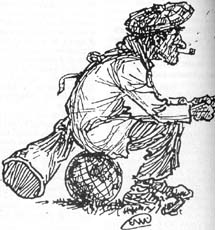 engravings are by CA Doyle and Clark Stanton among others. I have the original of one of the Clark Stanton’s, which David Stirk used as a frontispiece for his History of an Obsession published last year.’
engravings are by CA Doyle and Clark Stanton among others. I have the original of one of the Clark Stanton’s, which David Stirk used as a frontispiece for his History of an Obsession published last year.’
The large-paper edition, limited to fifty numbered copies, was issued early in 1876, though the title is dated 1875. A few special presentation copies of the large-paper edition have surfaced; in these, the title-page has been reset, though the wording remains the same, the verso has ‘Presentation Copy’ printed under the Thistle Club Coat of Arms, and bears a signed photograph of Robert Clark.
In Golf: a Guide to Information Sources, Joseph Murdoch describes Robert Clark’s book thus:
‘The first edition of this book is a rare volume to find today. The work is a collection of all the early writings that the compiler could find and so thorough was his work that very little of importance has been turned up since. It includes extracts from old club minute books, extracts from diaries, important Acts of Parliament, and municipal records that referred to the game. There are very early press reports, one of the earliest histories, obituaries of the two leading players of their respective eras (Alan Robertson and Tom Morris Junior) and some early songs and poems. An appendix in each of the subsequent editions offers the rules of the game as played at the time of the book’s publication in 1875.’ The second edition appeared in 1893, and facsimile reprints of this were issued in Britain in 1975 and in the United States in 1976.
Based as he is in Aberlady, and spending some time most days on Gullane Hill, Archie Baird often turns to The Golf Book of East Lothian by Rev John Kerr, Constable, Edinburgh, 1896. He has both the ordinary and the large paper edition. The ordinary edition sold at auction for under £50 in the early 1970s, and now sells for upwards of £800, while the large-paper edition, limited to 250 numbered copies signed by the author, fetches about £1,500.
‘The author was the minister of Dirleton. An interesting man. He wasn’t just a parsinomious East Lothian Meenister. He was a bit of a high-flyer, a considerable womaniser, and enjoyed intoxicating beverages. His womanising always included gifts of jewelry. This extravagance eventually ran him into bankruptcy.
John Kerr collected all the information about the golf courses and the clubs of East Lothian, wonderful stuff about the personalities, the problems, the triumphs, the whole cameraderie of golf. By the time Kerr came on the scene, the game was very popular. Everyone was playing, not just the aristocracy. The club at Dirleton Castle was founded in 1854 by ‘shopkeepers, working men and artisans’. In Kerr’s time, there was a club at Prestonpans, where the power station now stands.
In 1850 there were only 15 golf courses in the world, and they were all here on the East coast of Scotland. Fifty years later there were three thousand golf courses all over the world. Until 1850, the game was played with a feather ball. There was no other ball to play with. Feather balls were very expensive. In mint condition they were wonderfully hard and firm but they soon got soft and flabby. But in 1850, the game took off because of the introduction of the gutta-percha ball. It was cheap, easy to make, utterly indestructible. If the paint came off, all you had to do was repaint it and start again. If it got hacked, all you had to do was put it in a bucket of water, warm it up, round it off and start again.’
And as for the clubs…
‘You may never have handled a Stradivarius, but just look at the delicacy and the grace of that,’ said Archie Baird, lifting down one of 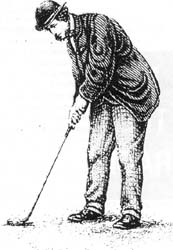 the clubs. ‘It’s a very early driver, made before 1800, almost certainly made by a bow maker. The shaft is ash, the head is pear, they put lead in the back and sheep’s horn on the front to protect the edge. This one was made before people put their name to them.
the clubs. ‘It’s a very early driver, made before 1800, almost certainly made by a bow maker. The shaft is ash, the head is pear, they put lead in the back and sheep’s horn on the front to protect the edge. This one was made before people put their name to them.
There is no real modern equivalent. The professional at Gullane is actually making me a club just now. But I’ve pinched the head off a club made in about 1920 because the persimmon at that time was wonderful quality such as you can’t get nowadays, and he’s putting it on a modern shaft. I wouldn’t play with one of those horrible steel things. They give no aesthetic pleasure at all, although they probably hit the ball better and they’re certainly more durable than wooden ones.’
A good source on the history of golf from the manufacturing point of view is to be found in the records of the patents that were taken out, some extraordinary affairs, such as a device like a diver’s helmet for keeping your head still while you practice your swing.
For book collectors’ reference, Archie Baird recommends Joseph Murdoch’s bibliography; a new bibliography by Dick Donovan is in preparation. A little bibliography that is something of a collectors’ item itself is Collecting Golf Books, 1743-1938 by Cecil Hopkinson, a London bookdealer. It was published by Constable in 1938 in the series Aspects of Book Collecting, bound either in dull red cloth, or in stiff paper covers. Archie Baird’s copy is inscribed by the author to William Beattie of the National Library of Scotland. For golf collectors interested in a wider scope there is The Encyclopedia of Golf Collectibles by Mort Oldman.
‘He shows the ceramics, the clubs, the books, the balls, the silver, everything to do with golf from the point of view of collecting. Once you get this bug it’s like Topsy, it just grows.’
from The Goff. An Heroi-Comical Poem in Three Cantos by Thomas Mathison, published by J. Cochran and Company, Edinburgh, 1743 – after the Acts of James the Second, one of the first things published on golf. It was originally published at the price of four pence.
Archie Baird is the author of Golf on Gullane Hill privately published in 1982 with sponsorship from Douglas M Kinney and the Palmer Capital Corporation, 2 edition 1985.
Copyright Jennie Renton 1995

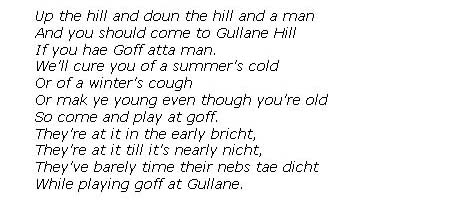
John A Jones on Wed, 9th Jun 2010 8:55 am
Enjoyed reading this. My grandfather was a violin maker and club maker. Alexander Mallas died c1895 . Do you have any of his clubs in your collection? I still have his name stamp and one viola.
I sometimes play at Gullane with Alex Jamieson, I think you know him. Best wishes, JAJ
John Fleming on Wed, 1st Mar 2017 4:41 pm
Archie-a voice from the past. Just got off the phone with Alan Lindsay to find you.
My son John, who is a professor of Creative Writing at South Florida University in Tampa, Florida and his family, are visiting Scotland around June 5-6. I think you would enjoy meeting him and I know he would love to meet you. Please email me when you can.
Still playing golf and walking at 85. Look forward to hearing from you.
Best- John